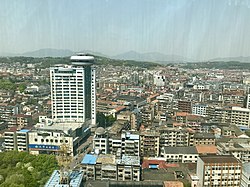Shengzhou
嵊州市 | |
|---|---|
 | |
| Coordinates: 29°36′N 120°49′E / 29.600°N 120.817°E | |
| Country | People's Republic of China |
| Province | Zhejiang |
| Prefecture-level city | Shaoxing |
| Area | |
| • County-level city | 1,789.07 km2 (690.76 sq mi) |
| • Urban | 1,789.07 km2 (690.76 sq mi) |
| • Metro | 3,002.06 km2 (1,159.10 sq mi) |
| Population (2020 census[1]) | |
| • County-level city | 675,226 |
| • Metro | 1,094,262 |
| Time zone | UTC+8 (China Standard) |
Shengzhou (Chinese: 嵊州; pinyin: Shèngzhōu), formerly Shengxian or Sheng County, is a county-level city in central Zhejiang, south of the Hangzhou Bay, and is the south-eastern part of the prefecture-level city of Shaoxing. It is about 1.5 hours drive from the provincial capital of Hangzhou through the Hangzhou-Ningbo, Shangyu-Sanmen Expressway. As of the 2020 census, its population was 675,226, but 1,094,262 lived in the built-up area made of Shengzhou City and Xinchang County largely being conurbated.[2]
